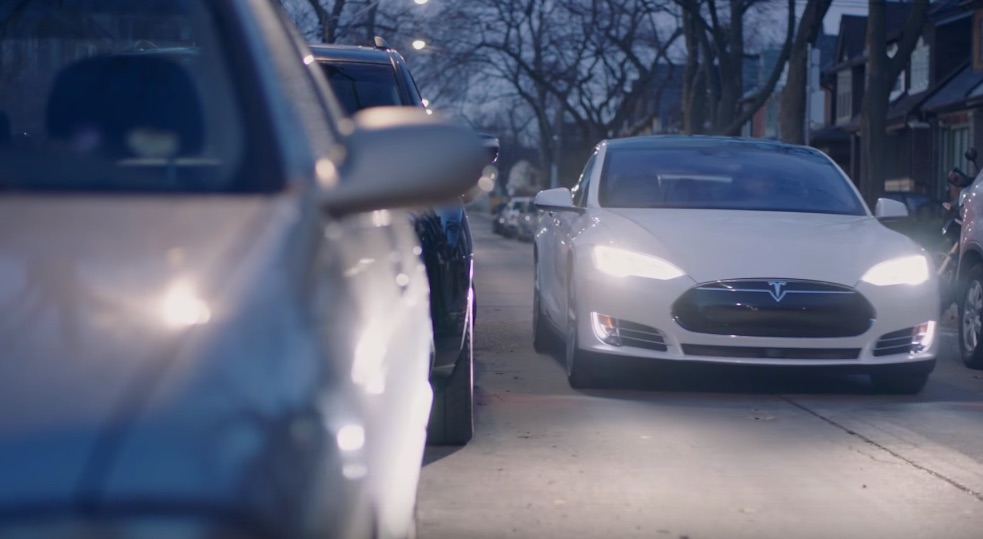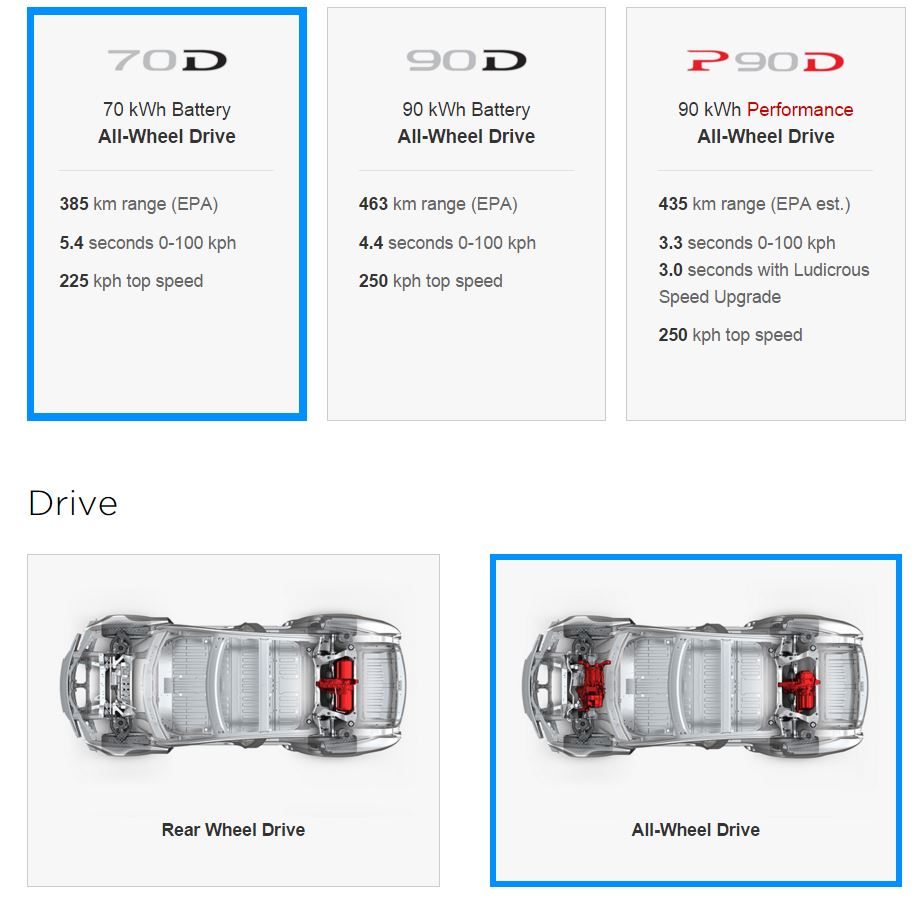News
Tesla Removes 85 kWh Battery Option in Canada, Is it a Sign?
Tesla will no longer offer the 85 kWh battery to Model S customers in Canada. It also has deleted the single motor rear wheel drive version of the car for people who live north of the border. The company has given no explanation for the changes.

The Model S can no longer be ordered with the 85 kWh battery according to the recent spot in the CanadianTesla Design Studio.
Updated Feb. 8, 2016: Tesla officially discontinues Model S 85 kWh battery option worldwide
The move has left many across the Tesla social groups wondering why the change only applies in Canada? Is this a signal that similar changes are about to happen in other countries as well? Elon has always maintained that an increase in battery capacity by 5% a year should be expected. Perhaps a 95kWh or even a 100 kWh battery may be in the offing for later this year.
The 85 kWh battery has been the largest size battery offering since Tesla first opened up Model S for orders in 2012. In 2013, Tesla discontinued a 40 kWh version of the battery due to lack of demand, leaving both a 60 kWh version and the 85 kWh pack as available options.
More recently, Tesla has discontinued the 60 kWh battery and replaced it with a 70 kWh version capable of 230 miles (385 km) of range, as well as introduced the 90 kWh battery capable of over 270+ miles, during the time when the company announced its Ludicrous mode option.
Tesla made the 70D variant of the Model S the entry level model, but then backtracked and reinstated a rear wheel drive version for $5,000 less. The company seems to be experimenting with different equipment combinations, trying to find the perfect alignment of affordability, performance, supply, and profits. By having the 70 kWh and 90 kWh as the only available battery options, Tesla is leaving a significant step in price between the battery configurations perhaps as a strategic move to cater to two different types of audiences – those that want a lower cost barrier of entry while having 200+ miles of range, and those that seek longer range with higher performance in mind.
It’s also possible that having a larger battery at the top of the range will allow Tesla to increase the size of the entry level battery as well. Perhaps a Model S 75D is lurking around the corner? A slightly larger battery would benefit the current entry level 70D Model X by giving it some extra range, something the super heavyweight electric crossover could leverage especially when put to use.
The configuration change in Canada may also presage a move to make dual motors standard across the range. Doing so would help streamline production and improve the number of cars Tesla can build each week.
Elon has said the company makes up to 20 running changes to its cars every month. Most of them are not publicized. Perhaps Tesla wants to avoid a situation like Chevrolet and Nissan found themselves in last year when they each announced significantly improved versions of the Volt and LEAF were coming soon. Sales of existing cars plummeted as a result. By simply implementing changes it deems necessary without fanfare, Tesla avoids falling into the same trap.

News
Tesla starts showing how FSD will change lives in Europe
Local officials tested the system on narrow country roads and were impressed by FSD’s smooth, human-like driving, with some calling the service a game-changer for everyday life in areas that are far from urban centers.

Tesla has launched Europe’s first public shuttle service using Full Self-Driving (Supervised) in the rural Eifelkreis Bitburg-Prüm region of Germany, demonstrating how the technology can restore independence and mobility for people who struggle with limited transport options.
Local officials tested the system on narrow country roads and were impressed by FSD’s smooth, human-like driving, with some calling the service a game-changer for everyday life in areas that are far from urban centers.
Officials see real impact on rural residents
Arzfeld Mayor Johannes Kuhl and District Administrator Andreas Kruppert personally tested the Tesla shuttle service. This allowed them to see just how well FSD navigated winding lanes and rural roads confidently. Kruppert said, “Autonomous driving sounds like science fiction to many, but we simply see here that it works totally well in rural regions too.” Kuhl, for his part, also noted that FSD “feels like a very experienced driver.”
The pilot complements the area’s “Citizen Bus” program, which provides on-demand rides for elderly residents who can no longer drive themselves. Tesla Europe shared a video of a demonstration of the service, highlighting how FSD gives people their freedom back, even in places where public transport is not as prevalent.
What the Ministry for Economic Affairs and Transport says
Rhineland-Palatinate’s Minister Daniela Schmitt supported the project, praising the collaboration that made this “first of its kind in Europe” possible. As per the ministry, the rural rollout for the service shows FSD’s potential beyond major cities, and it delivers tangible benefits like grocery runs, doctor visits, and social connections for isolated residents.
“Reliable and flexible mobility is especially vital in rural areas. With the launch of a shuttle service using self-driving vehicles (FSD supervised) by Tesla in the Eifelkreis Bitburg-Prüm, an innovative pilot project is now getting underway that complements local community bus services. It is the first project of its kind in Europe.
“The result is a real gain for rural mobility: greater accessibility, more flexibility and tangible benefits for everyday life. A strong signal for innovation, cooperation and future-oriented mobility beyond urban centers,” the ministry wrote in a LinkedIn post.
News
Tesla China quietly posts Robotaxi-related job listing
Tesla China is currently seeking a Low Voltage Electrical Engineer to work on circuit board design for the company’s autonomous vehicles.

Tesla has posted a new job listing in Shanghai explicitly tied to its Robotaxi program, fueling speculation that the company is preparing to launch its dedicated autonomous ride-hailing service in China.
As noted in the listing, Tesla China is currently seeking a Low Voltage Electrical Engineer to work on circuit board design for the company’s autonomous vehicles.
Robotaxi-specific role
The listing, which was shared on social media platform X by industry watcher @tslaming, suggested that Tesla China is looking to fill the role urgently. The job listing itself specifically mentions that the person hired for the role will be working on the Low Voltage Hardware team, which would design the circuit boards that would serve as the nervous system of the Robotaxi.
Key tasks for the role, as indicated in the job listing, include collaboration with PCB layout, firmware, mechanical, program management, and validation teams, among other responsibilities. The role is based in Shanghai.
China Robotaxi launch
China represents a massive potential market for robotaxis, with its dense urban centers and supportive policies in select cities. Tesla has limited permission to roll out FSD in the country, though despite this, its vehicles have been hailed as among the best in the market when it comes to autonomous features. So far, at least, it appears that China supports Tesla’s FSD and Robotaxi rollout.
This was hinted at in November, when Tesla brought the Cybercab to the 8th China International Import Expo (CIIE) in Shanghai, marking the first time that the autonomous two-seater was brought to the Asia-Pacific region. The vehicle, despite not having a release date in China, received a significant amount of interest among the event’s attendees.
Elon Musk
Elon Musk and Tesla AI Director share insights after empty driver seat Robotaxi rides
The executives’ unoccupied tests hint at the rapid progress of Tesla’s unsupervised Robotaxi efforts.

Tesla CEO Elon Musk and AI Director Ashok Elluswamy celebrated Christmas Eve by sharing personal experiences with Robotaxi vehicles that had no safety monitor or occupant in the driver’s seat. Musk described the system’s “perfect driving” around Austin, while Elluswamy posted video from the back seat, calling it “an amazing experience.”
The executives’ unoccupied tests hint at the rapid progress of Tesla’s unsupervised Robotaxi efforts.
Elon and Ashok’s firsthand Robotaxi insights
Prior to Musk and the Tesla AI Director’s posts, sightings of unmanned Teslas navigating public roads were widely shared on social media. One such vehicle was spotted in Austin, Texas, which Elon Musk acknowleged by stating that “Testing is underway with no occupants in the car.”
Based on his Christmas Eve post, Musk seemed to have tested an unmanned Tesla himself. “A Tesla with no safety monitor in the car and me sitting in the passenger seat took me all around Austin on Sunday with perfect driving,” Musk wrote in his post.
Elluswamy responded with a 2-minute video showing himself in the rear of an unmanned Tesla. The video featured the vehicle’s empty front seats, as well as its smooth handling through real-world traffic. He captioned his video with the words, “It’s an amazing experience!”
Towards Unsupervised operations
During an xAI Hackathon earlier this month, Elon Musk mentioned that Tesla owed be removing Safety Monitors from its Robotaxis in Austin in just three weeks. “Unsupervised is pretty much solved at this point. So there will be Tesla Robotaxis operating in Austin with no one in them. Not even anyone in the passenger seat in about three weeks,” he said. Musk echoed similar estimates at the 2025 Annual Shareholder Meeting and the Q3 2025 earnings call.
Considering the insights that were posted Musk and Elluswamy, it does appear that Tesla is working hard towards operating its Robotaxis with no safety monitors. This is quite impressive considering that the service was launched just earlier this year.









